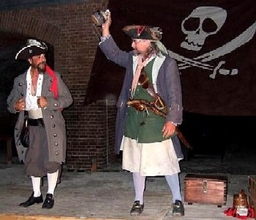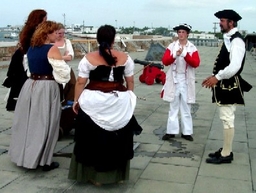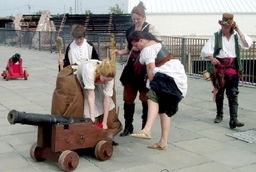-
Posts
5,186 -
Joined
-
Last visited
Content Type
Profiles
Forums
Events
Gallery
Everything posted by Mission
-
Wow. That's quite a bit different than what we finally agreed upon, although the concepts are essentially the same.
-
Hm. Sounds kind of like the mod guidelines I wrote several years ago... I wonder where it is? I can't find it.
-
There's a moderator's instruction page?
-
Excellent point. I actually did know that at one time because one or other of the Journals I was reading talked about taking a ship and letting it go when no offending goods were found. (Was it Rogers?) It was still based on the original proposition, though: a true privateer only took those ships with whom they were at war. In this case, the presumption being that Spanish ship was trading with, and thus indirectly abetting, the French.
-
I never tire of reading about all the things the coconut was used for. When Raphael Mission retired. I think he established a coconut plantation. “…their [the Maldiva Islands] only Product is Cocoa-nut. Their Trees are not so high nor gross bodied as those which grow on the Continent, or on Zeloan [sri Lanka], but their Fruit is pleasanter. Of that Tree they build Vessels of 20 or 30 Tuns. Their Hulls, Masts, Sails, Rigging, Anchors, Cables, Provisions and Firing are all from this useful Tree. It also affords them Oyl for their Kitchin and Lamps, Sugar and candied Sweet-meats, and pretty strong Cloth. Their Seas produce Abundance of Fish, but their Trade is chiefly from a small Shell-fish called Courie and the Bonetta.” (Hamilton, p. 286)
-

Auction Auctioneers Mark Mary
Mission posted a gallery image in Pirates in Paradise & Fort Taylor Pyrate Invasion, Key West, FL
-

All Girls Cannon Crew Crispy Admiring Mark
Mission posted a gallery image in Pirates in Paradise & Fort Taylor Pyrate Invasion, Key West, FL
-

Sea-Captain Alexander Hamilton on Sea-Life & Piracy
Mission replied to Mission's topic in Captain Twill
In case you ever need to know how to do this, here are the instructions. “The Way they catch them, as they told me, is, they drive large Stakes into the Ground for 2 or 300 Paces, in a Plain, and, about 100 Paces distant, they begin another row of Stakes, that almost meets one of the ends of the first Row, only having 7 or 8 Foot open between them, for a Door, and farther out from the Door-place is a wooden Porticullice or Trap-door, fitted to pull up or let down at Pleasure. When all is ready, they bring a female Elephant trained up for a Decoy, and she is put into the Chamber, and the Trap-door kept open. There are Men placed in a little close Place built on the Top of the Stakes at the Trap-door, and the female Elephant makes a loud doleful Mone. If a male Elephant is near, he presently approaches the Chamber, on the Outside, but finding no Entrance there, he walks along the Outside, till he finds the End, then walking back on the Inside of the Stakes, he finds the Door, and enters. As soon as he is in, the Watchmen let fall the Trap-door, and go and bring two tame Elephants to accompany him that is decoyed to their Stables. When they come near the Trap-door, it is pulled up and they enter, and place themselves on each Side. If he proves surly, they bang him heartily with their Trunks, and the Female bestows some Blows on him too. When he is tired with their Treatment, and finds no other Remedy but Patience, he even grows tame, and walks very orderly between his two Guards, withersoever they please to conduct him, and continues very sociable ever after, except when Rutting Time comes, and then, if he be young, he becomes very rude and troublesom. That Time is known by a great Sweating in his Head, so they have strong Fetters ready to put on his Legs, and fastned to a great Tree for eight or ten Days that his Madness continues.” (Hamilton, p. 281) -
Good point. I see that a lot in the medical journals. They often call the same surgical tool by several different names...sometimes in the same text. For example, I've seen the amputation knife called that, the capital knife, the crooked knife or blade and the curved knife among other things. There is always many names for everything....always..... often things get names afterwards like these petticoat-breeches or even pirates like Black Bart (which was nickname for B. Robets but was not used in his life time)... same with golden age of pyracy which is around 20th century invention.... While true, if you're re-enacting, you try to avoid using modern monikers if you know better. (I shall have something to say about the use of the word 'tourniquet' in English medicine in an upcoming web page, for example). I think Ed's original point it a good one. During period there was far less need to uniquely identify and label things. Considering that medicine was a somewhat scientific field. the fact that the authors of the time didn't agree on what to call something so central to their practice as a amputation knife is rather telling. This suggests to me that you might go into a cutlery shop and explain what you wanted so they could make you one rather than just asking for an amputation knife. Strict standardization doesn't seem to have been part of their lexicon, let alone their production.
-
I have actually seen that one before. It's intermittent, though. (Those are the worst sort of bugs...)
-
Good point. I see that a lot in the medical journals. They often call the same surgical tool by several different names...sometimes in the same text. For example, I've seen the amputation knife called that, the capital knife, the crooked knife or blade and the curved knife among other things.
-
Do you have any period evidence of this? (Not suppositions from a post-period author trying to make a case for his pet belief. There's a lot of that out there.)
-

John Woodall's the surgions mate Available in pdf
Mission replied to Mission's topic in Captain Twill
That link goes directly to the Woodall book. Moyle will undoubtedly pop up on the free books eventually. Universities are continuing to scan these books in and make them publicly available. For now, you can order it off Amazon for a pretty reasonable price if you really want to read it. Or you can go to a university and get the pdf via their database access. I explain how I did that on this page. -
It's a fad. Bring back my skull instead of fooling around with rounded corners.
-
Rounded corners is one of those idiotic web trends to which I refuse to bow on my web site. It's like the move towards jelly-bean cars in the 80s. (We still haven't managed to shake that one off entirely.)
-
I didn't know that. Cool.
-

John Woodall's the surgions mate Available in pdf
Mission replied to Mission's topic in Captain Twill
Post here and let me know what you think of it. (It is honestly the most difficult period document I've ever read. It was a big part of what led me to write my page about how to write in 17th/18th century style.) -
Silkie McDonough sent me some questions about Laudanum that I thought would be a good thing to answer here. (If you guys want private consultations, you have to pay the surgeon. ) >How was it obtained? It would be obtained from an apothecary. Laudanum is a mixture of substances as you will note from earlier posts in this thread. I don't know the process an apothecary would have gone through to get the opium (or, as I have seen it written in some books 'opheum'), but it seems to have mostly come from the East Indies along with a lot of the other drugs and spices during this period. >What was it used for most often? Pain or sleep or both? I have seen it recommended once or twice for encouraging sleep, but primarily in cases where the patients were in pain. So I would say opiates were used mainly as they are now: to alleviate pain. >How was it perscribed? Was it from a physician or an apocathary. I am not looking for a dissertation just generalities. On land, physicians prescribed it and apothecaries would have filled it. At least that's how it was supposed to go... Here's the dissertation. (The real answer to this question is not straightforward. Plus I like giving dissertations. You know that.) All of the surgical manuals I have from period contain recipes for drug mixtures, including one or two that give receipts for laudanum. So, despite the fact that surgeons weren't technically allowed to prescribe drugs, they obviously made them and administered them. On ships there really wasn't anyone else to do this, so they were given a chest of medicines and allowed to practice that bit of medicine. See, physicians didn't usually practice at sea. Some of the large BRN ships had a physician position, but a merchant ship (the favored target of pirates) rarely would. (They were too expensive to hire and mostly not needed.) Well... there is physician/privateer Thomas Dover...but he was considered a bit loony. He claims to have taken Mercury every day as a preventative, so that may have had something to do with it. In addition there appear to have been more than a few cases of Apothecaries prescribing drugs without Physician's scripts (although I can't point to any specific cases involving Laudanum or anything. I generally don't read physician or apothecary books unless they are directly related to the sea.) The Physicians complained about this to the Worshipful Society of Apothecaries of London and a lot of finger-pointing seems to have been the result with little real progress from my limited understanding. (So it's really not any different than any other attempt to strictly divide labor throughout history.)
-
Hey, you finally changed the regular member color so it can be read against a black background! And you re-enabled the ability to see the recently logged on members again. Cool.
-
Who quoted what, exactly? (Even if he quoted it incorrectly.)
-
This month's article on Pirate Era surgery features period information on the treatment of gangrene. (Click on that link to read it.) I have added a new section enumerating points that could be brought up by period pirate surgeon re-enactors. They are listed with a dash of humor. If folks like them, I may go back and add similar lists to the previous surgical procedure articles on my web page.
-
“Their [the Lacca Diva Island’s - or Laccadiva's] Product is only Cocoa-nuts and Fish. Of the Coca-nut Kernels they express Oyl, which is fine and clear, fitting for Lamps; and, when it is new, serves their Kitchins. Of the Rind of the Nut they make Cayar, which are the Fibres of the Cask that environs the Nut spun fit to make Cordage and Cables for Shipping, and for several other Uses. Their Fish they dry, and export to the Continent.” (Hamilton, p. 245)
-

Sea-Captain Alexander Hamilton on Sea-Life & Piracy
Mission replied to Mission's topic in Captain Twill
Here's a fun story for one and all. “In Anno 1668 the Prince came into the Dutch Fort [at Cannanore] to pay a Compliment to the Captain. He had brought about 50 Attendants with him. While the Prince was complimenting the Captain, the Malabars took the Opportunity of the Dutch Security and killed the Sentinel at the Gate; but the Dutch Soldiers being all in their Barracks, and their Arms ready, made a seasonable Sally, and drove the Malabars out, with the Loss of twenty of their Number; and the Dutch shut their Gate. The Fort is large, and the Governor’s Lodgings at a good Distance from the Gate, so that the Fray was over before either the Prince or the Dutch Captain knew any Thing of the Matter; and an Officer bringing News, the Prince ordered a Search to be made for the Ringleader, and being found, he sentenced him to be smeared over with Hony, and made fast to a cocoa-nut Tree in the Sun till he died. Next Morning the Sentence was put in Execution. These Cocoa-nut Trees producing a sweet Liquor called Toddy, bring vast Numbers of Wasps and large __ red Ants to drink the Liquor. Those Ants bite as painfully as the Stinging of Wasps. When the Sun begins to be hot, they leave the Top of the Tree, and burrow in Holes about the Root. In their Passage downward they fixt on the Carcase besmeared with Hony, and soon burrowed in the Flesh. The poor Miscreant was three Days in that sensible Torment before he expired. The Dutch Captain begged every Day for Pardon, or at least for a milder and quicker Death, but the Prince was inexorable.” (Hamilton, p. 243-4) -
No Luke, I am your Father. http://community.flixster.com/blog/luke-i-am-your-father-movie-misquotes




